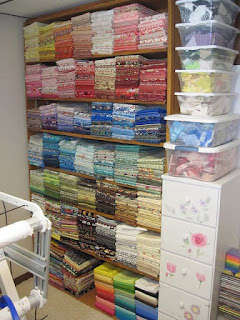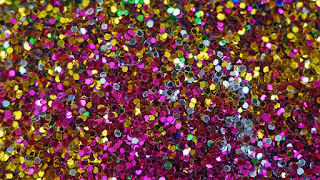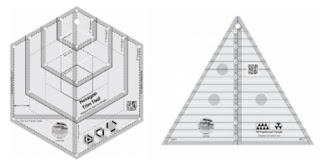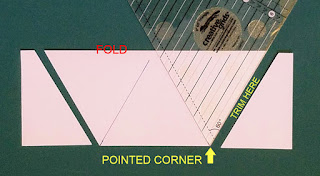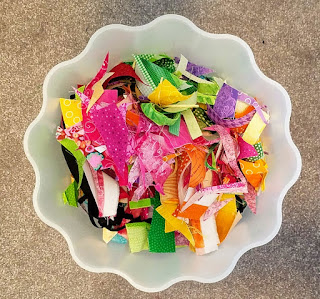I'm doing a little indoor gardening with fabric. This project will be published as part of a ruler program later, but I'm giving you a sneak peek. If you would like to do a little test sewing, make a flower or two. Let me know how you feel about the project in the comments section. I would love your feedback.
You are going to need a 60 Degree Ruler for this project. The formal instructions will also require a Hexagon Trim Tool. If you have one dust it off you are going to enjoy using it! If you don't have one, I have a little cheat for you to make a paper template until you can get out of the house and buy a hexagon ruler. I know you are going to want one. There are lots of fun ways to use it.
Meanwhile gather up some fabric scraps in greens and flower colors. I do mean scraps! You will need a variety of fabrics cut into 1 1/2" strips from 2" to 6" long. Scraps are perfect. The more fabrics the merrier but you can get away with as few as 5 shades of a color for each flower.
Now about that hexagon template.
You are going to need a regular sheet of paper, a pencil, your 60 degree ruler and rotary cutting supplies. Make sure you have a SIXTY DEGREE ruler. That's the one that is equal on all three sides.
Fold the paper in half. Measure 3 1/4" from the FOLD and cut a paper strip as shown.
Place the 3" line on the edge OPPOSITE the fold, centered on the paper. Draw a line on each side of the triangle. The clipped point will NOT reach the fold as shown.
4. Rotate the ruler and place a POINTED corner (not the flat tip) against the line you have drawn, placing the point on the edge of the paper opposite the fold. Cut the angle as shown on each side of the drawn triangle.
5. Unfold the paper.
You may want to make one more template before we are ready to sew.
Each flower starts with a pentagon in the center. Pentagons have 5 sides. We want the pentagons to have wonky sides for a more natural look. The easiest way to make your template is to draw a star, the way you did in elementary school. The center of your star is a pentagon! Cut out the center shape. This will be the template for the center of each flower. If you are comfortable cutting this shape freehand there is no need to make a template.
The good news is that we don't want all of the sides of the pentagon to be equal.
If yours is a bit wonky - it is perfect!
If you use freezer paper for this template, you can press the waxy side to the fabric and it will stick. That makes it easier to cut out the shape.
To make a flower, cut the center fabric using the template. Stitch a scrap strip to one side of the center pentagon. Press the seam toward the strip. Trim one end of the strip using the edge of the pentagon as your guide.
Repeat the process, adding a strip and trim, working your way around the center pentagon in the same way you would make a log cabin block. Trimming only one side helps you to stay organized and know where to add the strip especially if you decide to make several blocks at one time.
Once you have added fabric to all five sides, trim the block into a wonky pentagon shape. Notice that the sides of the new shape are not parallel to the center pentagon. Just trim, no template required. My goal was to not have any of the sides be a perfect 90 degrees to help the flowers look more natural.
I used the places where the strips intersect to help guide me with the trimming. There is no right or wrong here. Even if your pentagon turns into an octagon, just trim and keep adding rounds of strips until the flower is larger than the paper template or the 6" hexagon on the ruler. Trimming after each round makes it easier to stay organized.
With all the trimming you are going to create some very pretty trash.
Remember, you are using up scrap fabric.
If you are a SERIOUS saver, these pieces might be the beginning of a collage quilt!
Once your flower is a bit larger than the size needed, use the ruler or the template to cut it to size. To trim with the ruler, cut two sides, rotate the ruler and align the markings on the ruler with the trimmed edges. Trim two more sides, repeat until all sides are trimmed. If you are using the paper template, either mark the trim lines on the fabric or hold a rotary ruler against the paper edge to trim. Be careful not to cut the paper and change the size of your pattern.
One flower finished!
You will need 7 finished flowers for the table topper.
There is nothing wrong with perfect hexagon shaped flowers, but for that "art school graduate" look, feel free to clip a few corners with green fabric to make things look a little more natural.
(Or to fill in a gap if something went wrong when trimming ; )
Now for some leaves.
I thought it would be more fun to make them scrappy! I like the scrappy look, but I do have to admit that it adds considerable bulk to the seams where the triangles meet. For the pieced leaves, I stitched 1" and 1 1/4" strips together to form a strip set 3 1/2" wide. Using the 60 degree triangle I cut 12 triangles from the 3 1/2" wide pieced strip. If you have trouble stitching through bulky layers, I suggest that you cut 12 solid green leaves from a 3 1/2" fabric strip.
PUTTING IT ALL TOGETHER
Arrange your flowers and leaves in a hexagon as shown below. Twist and turn the pieced leaves to create random movement in your garden. When you are happy with the arrangement, begin sewing units together as shown. Then join the units together in rows. If you press all the seams toward the leaves, they will "nest" as you sew the units together. This is a decorative table topper that won't get much laundering so if you feel better pressing the seams open, that works too.
Even with the extra bulk of the pieced leaves,
look how well the corners meet when you use the right tools!
A bit of bulk is nothing that a nice straight seam and a good quality steam iron can't handle!
The competed top measures approximately 18" side-to-side or 21" point-to-point.
That's a bit small for our large square coffee table, so I added a dark green border cut 3 1/2".
After some simple machine quilting I may decide to trim that down. But for now, it's perfect.
It's always easier to trim to make something smaller than to add-on after the project is quilted.
The top of our hexagon garden is complete!
If you prefer a long thin runner, simply make more flowers and make the rows longer.
If you decide to do a little indoor gardening, please post a photo in the comments section!
If you have comments on what you liked or didn't like about making the flowers
I would love to hear that too.
Enjoy!


